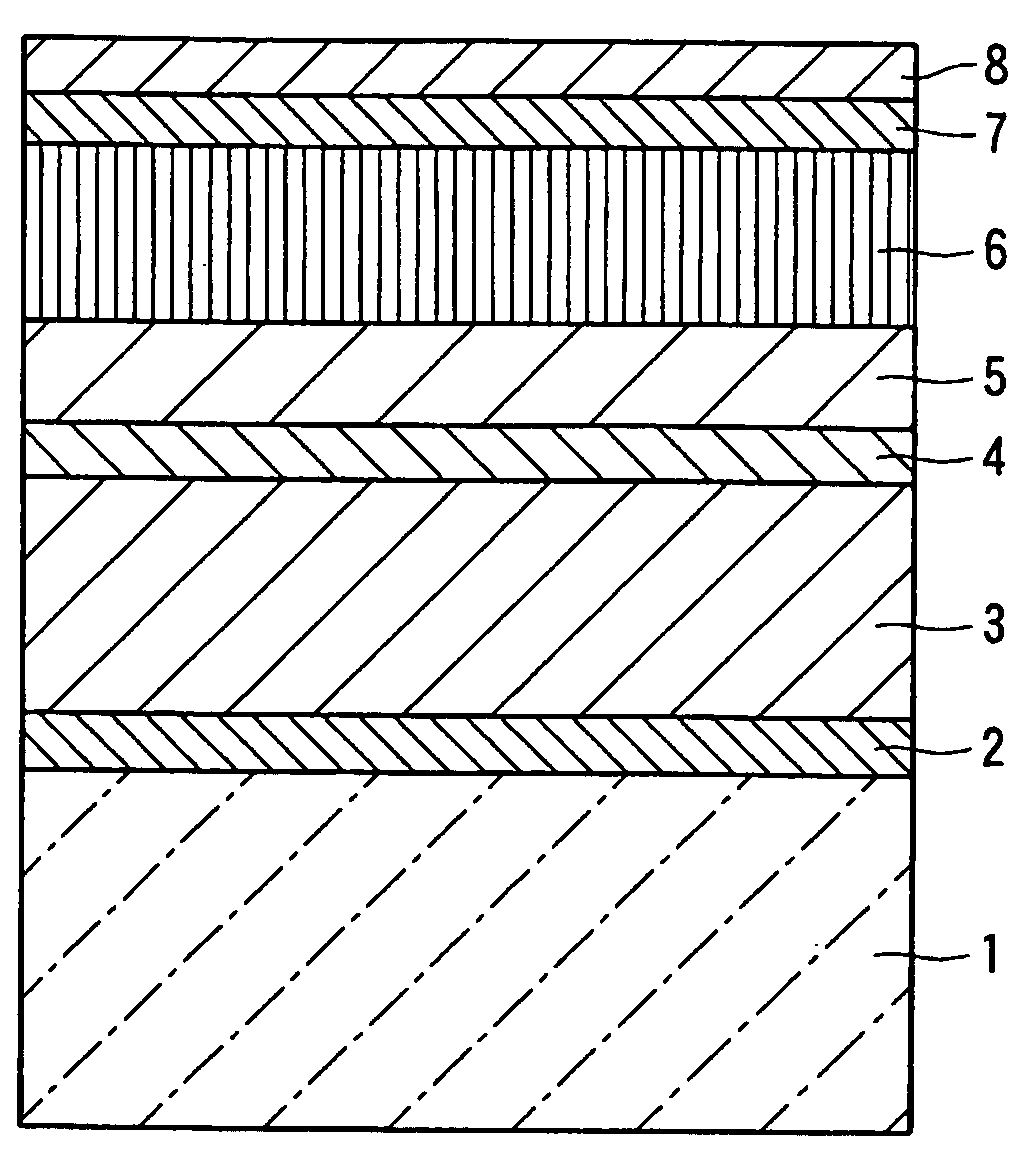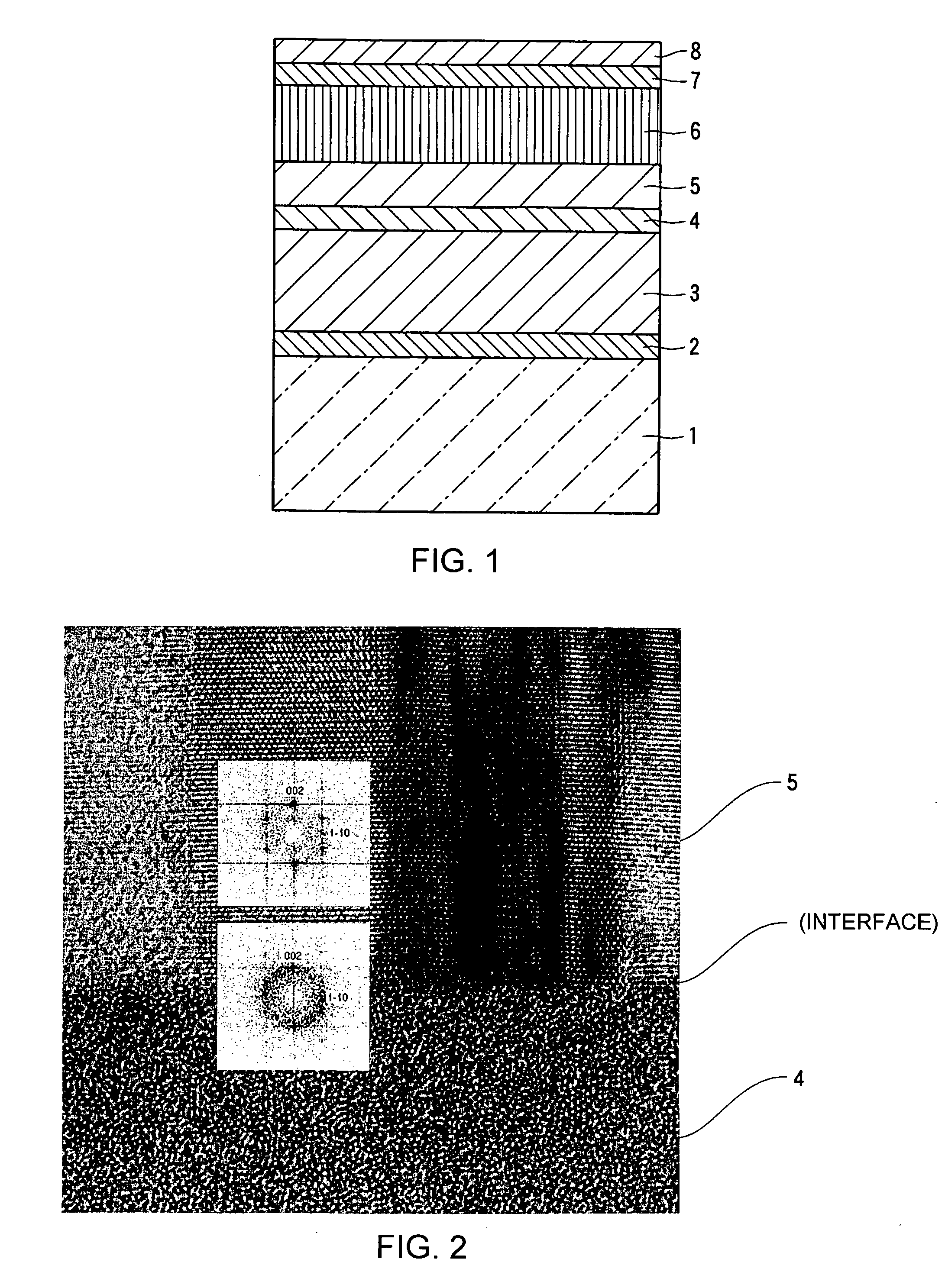Perpendicular magnetic recording medium
a magnetic recording medium and perpendicular technology, applied in the field of perpendicular magnetic recording medium, can solve the problems of inability to achieve good recording quality, easy occurrence of thermal fluctuation error, disadvantages of in-plane magnetic recording system, etc., and achieve the effect of higher recording surface density
- Summary
- Abstract
- Description
- Claims
- Application Information
AI Technical Summary
Benefits of technology
Problems solved by technology
Method used
Image
Examples
example 1
[0090] In Example 1, a perpendicular magnetic recording medium as a magnetic disk was produced in the following manner. An amorphous aluminosilicate glass was formed into a disk-like shape by direct pressing to produce a glass disk. The glass disk was successively subjected to grinding, polishing, and chemical strengthening to obtain a nonmagnetic flat disk substrate comprising a chemically strengthened glass disk.
[0091] The surface roughness of a principal surface of the disk substrate was measured by an atomic force microscope (AFM). As a result, the substrate had a flat and smooth surface profile given by Rmax of 4.8 nm and Ra of 0.42 nm. Herein, the surface roughness Rmax is defined in Japanese Industrial Standard JIS B0601 as a maximum height representative of a difference between a highest point and a lowest point of the surface and described, for example, in U.S. Pat. No. 6,544,893B2. The surface roughness Ra is also defined in Japanese Industrial Standard JIS B0601 as an ar...
example 2
[0106] In Example 2, on a substrate similar to that in Example 1, the following layers were successively deposited. As shown in Table 1, the soft magnetic underlayer 3 was an amorphous (noncrystalline) cobalt-tantalum-zirconium (Co—Ta—Zr) (Co: 88 at %, Ta: 7 at %, Zr: 5 at %) alloy layer. The first nonmagnetic underlayer 4 was a nonmagnetic amorphous nickel-tantalum (Ni—Ta) (Ni: 45 at %, Ta: 55 at %) alloy layer. The second nonmagnetic underlayer 5 was a nonmagnetic ruthenium (Ru) metal layer having a hexagonal close packed (hcp) crystal structure. The perpendicular magnetic recording layer 6was a hard magnetic layer comprising a cobalt-chromium-platinum-boron (Co—Cr—Pt—(B) alloy (Co: 66 at %, Cr: 17 at %, Pt: 13 at %, B: 4 at %). The materials of other layers and the producing conditions were similar to those in Example 1.
[0107] The perpendicular magnetic recording medium had magnetic characteristics shown in Table 1. The coercive force (Hc) was equal to 4500 oersted, the squarene...
example 3
[0108] In Example 3, on a substrate similar to that in Example 1, the following layers were successively deposited. As shown in Table 1, the soft magnetic underlayer 3 was an amorphous (noncrystalline) cobalt-tantalum-zirconium (Co—Ta—Zr) (Co: 88at %, Ta: 7 at %, Zr: 5 at %) alloy layer. The first nonmagnetic underlayer 4 was a nonmagnetic amorphous chromium-nickel-tantalum (Cr—Ni—Ta) (Cr: 50 at %, Ni: 40 at %, Ta: 10 at %) alloy layer. The second nonmagnetic underlayer 5 was a nonmagnetic ruthenium (Ru) metal layer having a hexagonal close packed (hcp) crystal structure. The perpendicular magnetic recording layer 6 was a hard magnetic layer comprising a cobalt-chromium-platinum-silicon dioxide (Co—Cr—Pt—(SiO2)) alloy ((Co: 64 at %, Cr: 16 at %, Pt: 20 at %): 92 mol % —SiO2: 8 mol %). The materials of other layers and the producing conditions were similar to those in Example 1.
[0109] The perpendicular magnetic recording medium had magnetic characteristics shown in Table 1. The coer...
PUM
| Property | Measurement | Unit |
|---|---|---|
| diameter | aaaaa | aaaaa |
| diameter | aaaaa | aaaaa |
| diameter | aaaaa | aaaaa |
Abstract
Description
Claims
Application Information
 Login to View More
Login to View More - R&D
- Intellectual Property
- Life Sciences
- Materials
- Tech Scout
- Unparalleled Data Quality
- Higher Quality Content
- 60% Fewer Hallucinations
Browse by: Latest US Patents, China's latest patents, Technical Efficacy Thesaurus, Application Domain, Technology Topic, Popular Technical Reports.
© 2025 PatSnap. All rights reserved.Legal|Privacy policy|Modern Slavery Act Transparency Statement|Sitemap|About US| Contact US: help@patsnap.com


